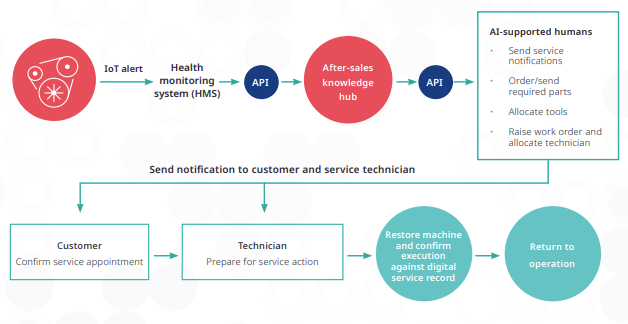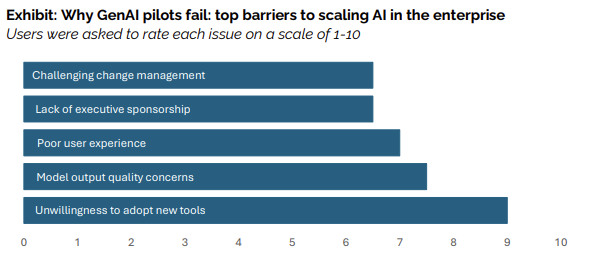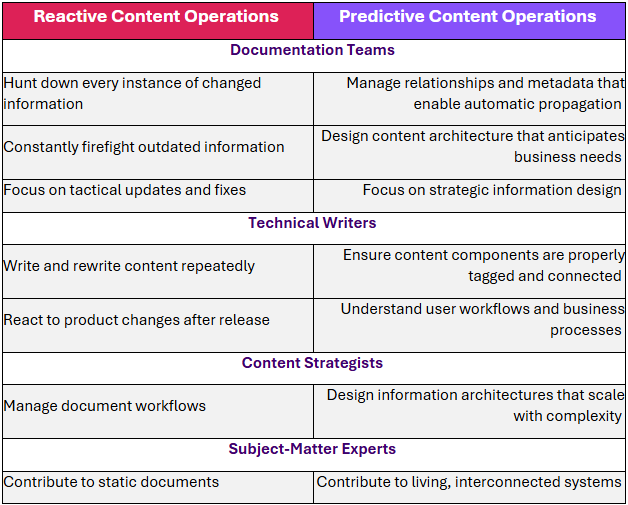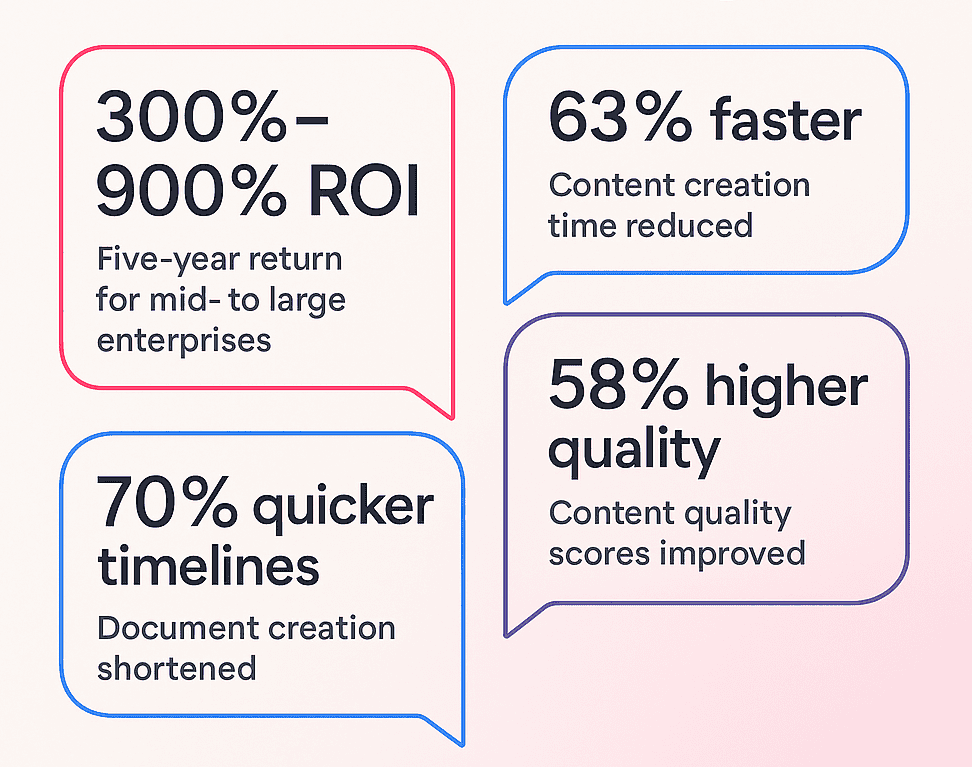What if your content could actually think ahead?

Why the smartest organizations are rethinking what content actually is
Most business content operates in reactive mode. A product changes, so documentation gets updated. A regulation shifts, so policies get revised. A customer complains, so help articles get patched. The cycle is perpetual, and the content is always a few steps behind.
This reactive model made sense when content was simpler and change was slower. But today's organizations face accelerating product cycles, expanding compliance requirements, and customer expectations for personalized, always-current information. The traditional approach of treating content as static deliverables – documents that get "finished" and published – can't keep pace.
What if content could flip from reactive to predictive? Instead of chasing change, what if organizations could build content infrastructure that anticipates needs, adapts automatically, and enables the business to move faster? This isn't speculative – in the world of tech docs, we are seeing more and more leading organizations make this shift – to stop treating content as static deliverables and start treating it as a strategic business enabler.
The reactive trap
The document paradigm we explored in our previous post creates an inherently reactive content operation. When information lives in isolated files, updating means hunting down every instance where that information appears. A simple product specification change might require updates across dozens of manuals, web pages, and training materials.
This scattering creates lag. By the time all instances are found and updated, business reality has already shifted again. And what ends up happening is you have customer support handling tickets based on outdated procedures. Sales teams distributing materials that contradict current policy. Field technicians working from manuals that don't match the latest software release.
The reactive cycle becomes self-reinforcing. Teams spend so much time chasing updates that they have no bandwidth to anticipate what's coming next. Content debt accumulates faster than it can be paid down. Quality suffers under the pressure to just keep up.
The infrastructure alternative
Structured content fundamentally changes this dynamic. Instead of information scattered across documents, knowledge exists as interconnected components with rich metadata describing what each piece is, how it relates to other pieces, and where it should be used.
An easy way to think of it is like moving from a printed map to a GPS system. A map is static, useful only for what existed when it was printed. A GPS, however, is dynamic. It knows the terrain, it understands context (traffic, weather, road closures), and it adapts your route accordingly.
Structured content works in the same way. It “knows” what it is (a procedure, a safety warning, a product spec), how it relates to other components, and where it should be used. Because of this, it can be automatically assembled, adapted, and reused across multiple outputs and contexts.
And this is why changing the mindset towards documentation is so important – this is more than just better organization, it's a different category of content system. Change a product specification once, and every manual, web page, and training module that references it updates simultaneously. The system knows the relationships and maintains consistency without human intervention. The technology enables it, but only if teams think beyond documents first.
More importantly, structured content enables prediction. Because components are tagged with metadata – product versions, audiences, compliance requirements, lifecycle stages – systems can anticipate needs. When a product enters end-of-life status, deprecation notices can be programmed to appear automatically. When regulation changes, affected procedures can be surfaced for review. When customer support tickets spike around a particular topic, the system can flag content gaps before they become widespread problems.
How predictive content works
The technical architecture that enables predictive behavior isn't mysterious. It relies on three key elements working together:
- Rich metadata. Every content component carries information about itself: what type of content it is (procedure, warning, specification), who it applies to (roles, regions, product versions), and how it connects to other components. This metadata makes content machine-readable and enables automated decision-making.
- Relationship mapping. Components link to each other through explicit relationships rather than just sitting side by side in a document. A safety warning knows which procedures it applies to. A troubleshooting step knows which product configurations it addresses. These relationships enable cascading updates and intelligent assembly.
- Event-driven workflows. Instead of waiting for humans to remember what needs updating, the system responds to triggers. Product lifecycle changes, regulatory updates, support ticket patterns, and user behavior analytics all feed into automated workflows that surface relevant content for review.
Real examples of predictive content
A leading global technology company implemented what they call 'Content Lifecycle AI' across their massive content operation—supporting 300 content creators and translators globally. When they release software updates, AI automatically identifies which help articles, training modules, and customer communications need revision based on the features that changed. As their content manager notes, they've achieved 80% automation in translation work, 90% automation in content syndication, and a 50% topic reuse rate. Instead of scrambling to update hundreds of documents after release, updates deploy alongside the software.
In manufacturing environments, organizations are implementing what RWS calls 'Content-as-a-Service' approaches where IoT sensors trigger automated content delivery. When Health Monitoring Systems detect specific operational parameters, the system automatically delivers targeted maintenance procedures to technicians' devices, along with relevant parts information and safety warnings. The content is filtered based on the exact equipment model, maintenance history, and current conditions.

In regulated industries, organizations are implementing automated compliance monitoring through solutions like the Tridion Docs and Be Informed integration. Be Informed's platform monitors regulatory feeds and uses semantic interpretation to automatically cross-reference new requirements with existing structured content in Tridion Docs. When regulations change, the system automatically flags affected procedures and policy documents for review, enabling organizations to address compliance proactively rather than waiting for audits to find gaps.
The AI factor
The relationship between structured content and AI implementation reveals why this shift matters strategically. MIT’s recent State of AI in Business report found that 95% of generative AI efforts produce no measurable return. The report found that the critical factor responsible for the ‘GenAI Divide’ is the “learning gap” – AI systems are unable to “adapt, remember, and evolve” in response to business requirements.
“The primary factor keeping organizations on the wrong side of the GenAI Divide is the learning gap, tools that don't learn, integrate poorly, or match workflows.”
The GenAI Divide: State of AI in Business 2025, MIT NANDA
In other words, these systems fail because they lack the structured, contextual data they need to operate effectively.
This failure connects directly to the barriers organizations face when scaling AI initiatives. The same report identified that among the top obstacles to AI adoption are "model output quality concerns" and "unwillingness to adopt new tools." These barriers reflect a fundamental tension: professionals who use AI tools personally often describe them as unreliable when integrated into enterprise systems. The difference lies in expectations and context. Personal AI use tolerates occasional inaccuracy, but enterprise applications demand consistency and reliability that unstructured content simply cannot provide.

Generative AI systems perform poorly when fed unstructured documents because they can't distinguish between current and outdated information, can't understand how pieces of content relate to each other, and can't maintain context across complex workflows. They hallucinate not because they're inherently unreliable, but because they're working with inherently unreliable input.
Structured content solves this problem by providing AI systems with clean, contextual, relationship-rich data. A customer service AI can reliably answer questions because it knows which procedures apply to which product versions. A field service AI can provide accurate troubleshooting guidance because it understands how symptoms relate to solutions. A compliance AI can identify risks because it knows how regulations map to business processes.
Organizations that build this foundation first will have significant advantages as AI capabilities continue advancing.
What changes operationally
Moving from reactive to predictive content transforms how documentation teams work:

This transformation delivers benefits throughout the organization. Quality improves because consistency becomes automatic rather than aspirational. Compliance becomes proactive rather than reactive. Product managers can launch features knowing that documentation will be ready simultaneously. Customer support can trust that their knowledge base reflects current reality. Sales teams can access materials that always align with current capabilities and policies.
When content operates predictively, it stops being a bottleneck and starts being an enabler of business agility.
Implementation realities
This transformation doesn't happen overnight. Organizations typically start with high-impact, well-defined content domains where the benefits are clearest – perhaps field service procedures, compliance documentation, or customer onboarding materials.
The key is building the technical foundation while simultaneously shifting team mindsets from document production to content architecture design. Both elements are necessary; neither is sufficient alone.
Success requires commitment from leadership because the upfront investment in a Component Content Management System (CCMS) and new workflows creates costs before benefits become visible. But organizations that make this investment consistently report significant long-term advantages in content quality, team efficiency, and business agility. Companies typically achieve a five-year ROI ranging from 300% for mid-market organizations to over 900% for very large enterprises. Organizations using structured content report a 63% reduction in content creation time and a 58% improvement in content quality scores, while some achieve up to 70% reduction in document creation timelines.

(source: When documents no longer cut it, what's next? - RWS)
The strategic imperative
The shift from reactive to predictive content isn't optional for organizations that want to remain competitive. Customer expectations for accurate, personalized, always-current information continue to rise. Regulatory environments continue to grow more complex. Product cycles continue to accelerate.
Organizations that continue operating reactively will find themselves perpetually behind, with content teams overwhelmed by the pace of necessary updates and customers receiving inconsistent or outdated information.
Those that build predictive content infrastructure will handle complexity more gracefully, respond to change more quickly, and deliver better experiences with less effort.
The question isn't whether to make this shift, but how quickly it can be accomplished. The organizations moving first are building advantages that will compound over time.
The journey continues
This is the seventh installment in our ten-part series exploring what it really takes to move from unstructured to structured content – not just the technical transformation, but the mental and organizational shifts that make it possible.
- Part one: If it’s not broken, why fix it?
- Part two: A practical guide to structured content migration and streamlining content operations
- Part three: Trapped in the document paradigm
- Part four: Accelerating speed to market: How structured content drives competitive advantage
- Part five: Change is a people problem, not a tech problem
- Part six: Your roadmap to better compliance: why unstructured documents are a risk
Look out for part eight, coming soon.
Ready to explore what structured content could unlock for your organization?
Download our white paper to see how others are making the transition, and discover the practical steps that can start your own transformation.
